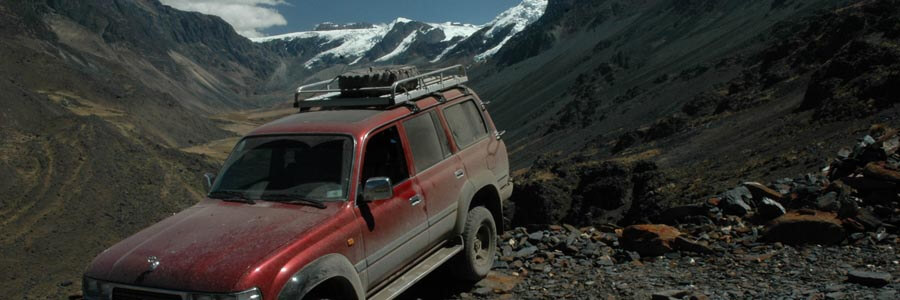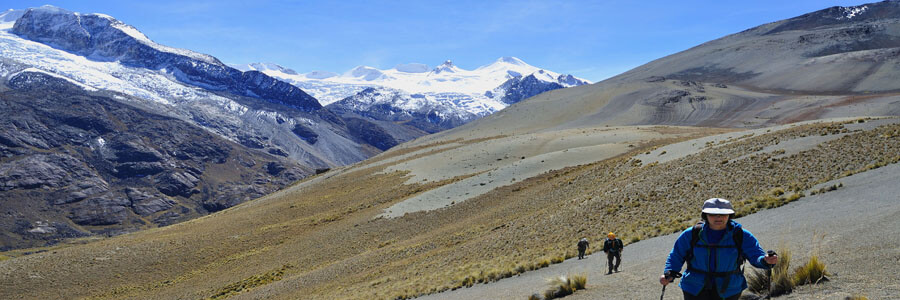Because of its complex and diverse geography, South America hosts the largest number of bird's species on the planet. Following there is a short list of the most known species organized on their ecological environment
Highlands and Mountains
Approximately 120 birds species can be found in the Altiplano and Andean regions, many of them are endangered because mining pollution, eggs collection, and hunters who kill them for their meat, their feathers, and to sell them to zoos.
Condor
The largest of all the birds on the world; the Condor (Vultur Gryphus Fam. Cathartidae) called the Royal Condor, with a wing span up to 3 m / 9.84 ft , and weight up to 20 kg / 44 pounds is also the heaviest flying bird, it is actually a glider, must jump down from a cliff to takeoff. It is an important icon in the Andean mythology and also included on some of the National Symbols. With some luck, they can be seen in the eastern mountain ranges. They are almost black with bald red heads, and males have white necks.
Caracaras
The most regularly seen bird in the highlands; the Caracara (Fam. Falconidae) is a scavenger that can easily found on the roadsides waiting for food. Thay are black and white with yellow beak and red face, juvenals are brown.
Flamingos
Depending of migration patterns, Flamingos (Fam. Phoenicopteridae) can be seen in lakes and Salt Flats farther south. There are three kinds: the Andean Flamingo or Parina Grande (Phoenicoparrus Andinus), Chilean Flamingo (Phoenicoparrus Chilensis), and the Puna Flamingo (Phoenicoparrus Jamesi).
Hummingbirds
The most amazing birds of the highlands are the Hummingbirds, which can be found up to 5000 m / 16400 ft. In order to survive to the altitude this birds grew up to incredible size (compared with their generic mates from central America), and have been adapted to the low night temperatures by reducing their body temperature from 39.5º to 15º C / 103º F to 59º F, and its heart rate from 1200 to 40 beats per minute.
Andean Rhea
The Andean Rhea is the South American ostrich. They can be seen in the highland plains above 3500 m / 11480 ft. A similar specie can be found in the lowland plains at 400 m / 1312 ft.
Other birds
Plains, lakes, rivers, and marshes in the highlands support a variety of birds like: Geese, Ducks (Anatidae), Gulls (Laridae), Pigeons and Doves (Columbidae), Lapwings (Charadiidae), Kingfishers (Alcedinidae), Woodcreepers (Dendrocolaptidae), Antbirds (Formicariidae), Flycatchers (Tyrannidae), Swallows (Hirundinidae), Finches (Fringillidae), Timanous (Tinamidae), Owls (Tytonidae), Coots (Rallidae), Ibises (Threskiornithidae), and many more.
Rainforest and Amazon basin
American vultures
(Fam. Cathardidae), these carrion feeders are probably some of the most common birds in the tropical forest. They are related to hawks and soar with great proficiency and find most of their food through eyesight. Hawks, eagles and kites (Fam. Accipitridae) belong to this large cosmopolitan family of diurnal predators, all possess a strong hooked bill and gripping feet but are otherwise notably heterogeneous in appearance and behavior.
Ducks and Geese
(Fam. Anatidae), Grebes (Fam. Podicipedidae), and Petrels (Fam. Procellariidae) are expert swimmers and divers, they are rarely seen on land except when nesting (some duck species are arboreal). They normally make floating nests attached to emerging vegetation. Cormorants (Fam. Phalacrocoracidae) are a widespread and ancient group, they eat mostly fish taken in an underwater chase. They are sociable and nest colonially, often in tremendous aggregations on the ground or small trees. Herons and Bitterns (Fam. Ardeidae), Storks (Fam. Ciconiidae), gallinacean like birds like Curassows (Fam. Cracidae), a typical marsh inhabitant the Coots (Fam. Rallidae), and Ibises (Fam. Threskiornithidae) are some of the common birds that can also be seen in Inland lakes, rivers, and swampy areas of the Amazon basin.
Parrots
(Fam. Psittacidae) are one of the widest distributed in the tropical forest, like the noisy Parakeets or the beautiful Macaws that mate for live. The Hoatzin (Fam. Opisthocomidae) is a peculiar neotropical bird related to the Cuckoos. They feed primarily on leaves and shoots of plants. At hatching they possess a claw on each wing that permits them to clamber about bushes. When frightened, the young drop into water below the nest and swim or die safely, later climbing back to the nest using their claws, bill and feet.
Owls
(Fam. Tytonidae) are found virtually worldwide and are mainly nocturnal hunter of small rodents, birds, occasionally snakes and frogs, and even insects. It has proven a great benefit to those engaged in agriculture. They show great fidelity to nest sites, which may be buildings, steeples, or hollow logs.
Other birds
Several more species of birds can be watched in the lowlands, either in the savannas, the deep jungle, or the lakes and rivers shores, some of them are: Pigeons and Doves (Fam. Columbidae), Lapwings (Fam. Charadiidae), Nightjars (Fam. Caprimulgidae) Hummingbirds (Fam. Trochilidae), Quetzals (0Fam. Trogonidae), Kingfishers (Fam. Alcedinidae), Toucans (Fam. Ramphastidae), Woodpeckers (Fam. Picidae), Woodcreepers (Fam. Dendrocolaptidae), Antbirds (Fam. Formicariidae), Flycatchers (Fam. Tyrannidae) are one of the most consistent groups in the lowlands, Swallows (Fam. Hirundinidae), Vireos (Fam. Vireonidae), Oropendolas (Fam. Icteridae), Tanagers (Fam. Thraupidae), Finches (Fam. Fringillidae), Tnamous (Fam. Tinamidae), and many more.
Pacific coastline & South forest
Humbolt Pinguin or "Pajaro Niño"
(Scheniscus Humbolt) live in a very desertic terrain at the cost neat the Atacama desert. "Magallanes" (Scheniscus Magallanicos) is very common penguin more to the south. near the Antartic the most common penguins are: "Pinguino Adela" (Pygoscelis Adeilae), "Pinguino Papua" (Pygoscelis Papua), "barbiquejo (Pygoscelis Antarctica),"Pinguino Rey" (Aptenodytes Antagonica) and "pinguino Emperador" (Aptenodytes Forsteri).
Pelicans
(Pelecanus Thagus), Cormorants (Phalacrocorax Brasilanum and Phalacrocorax Atriceps) and Sea Guls (Larus Dominicanos and Larus Modestus) are some of the most common birds at the Pacific.
The "Playero Blanco"
(Calidris Alba) is one of the most common and numerous birds ; always running towards and backwards avoiding the waves and eating at the coastline.
Hawks, eagles and kites
(Fam. Accipitridae) belong to this large cosmopolitan family of diurnal predators, all possess a strong hooked bill and gripping feet but are otherwise notably heterogeneous in appearance and behavior.
Other birds
Kingfishers (Ceryle Torcuata), Parraquites (Ericognatus Ferrugines), Geese (Chloepaga Hibrida) and many more.








